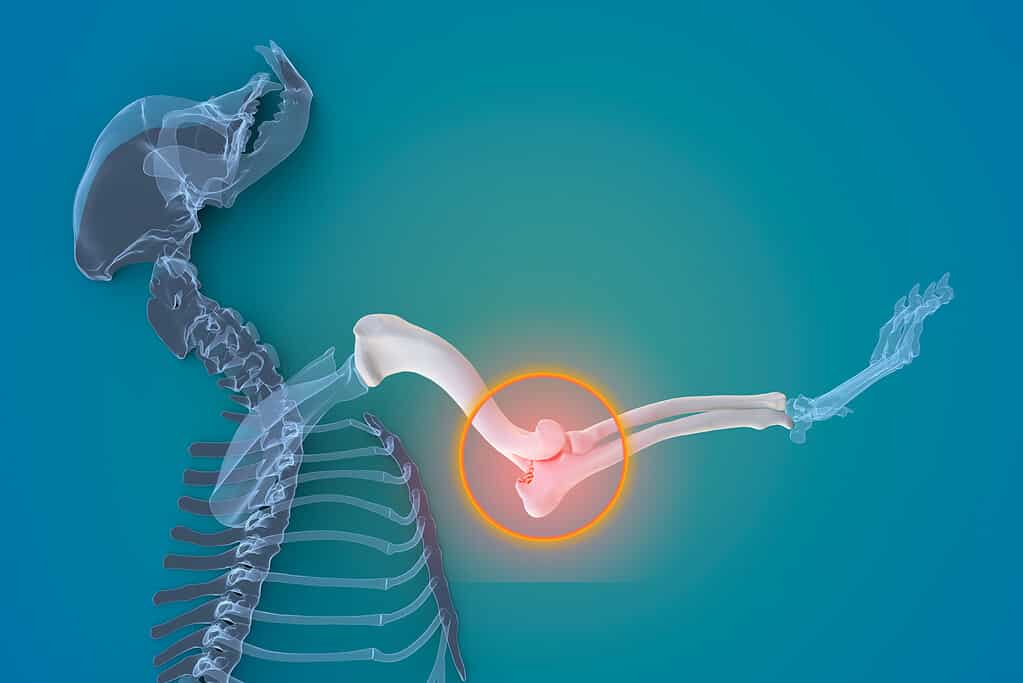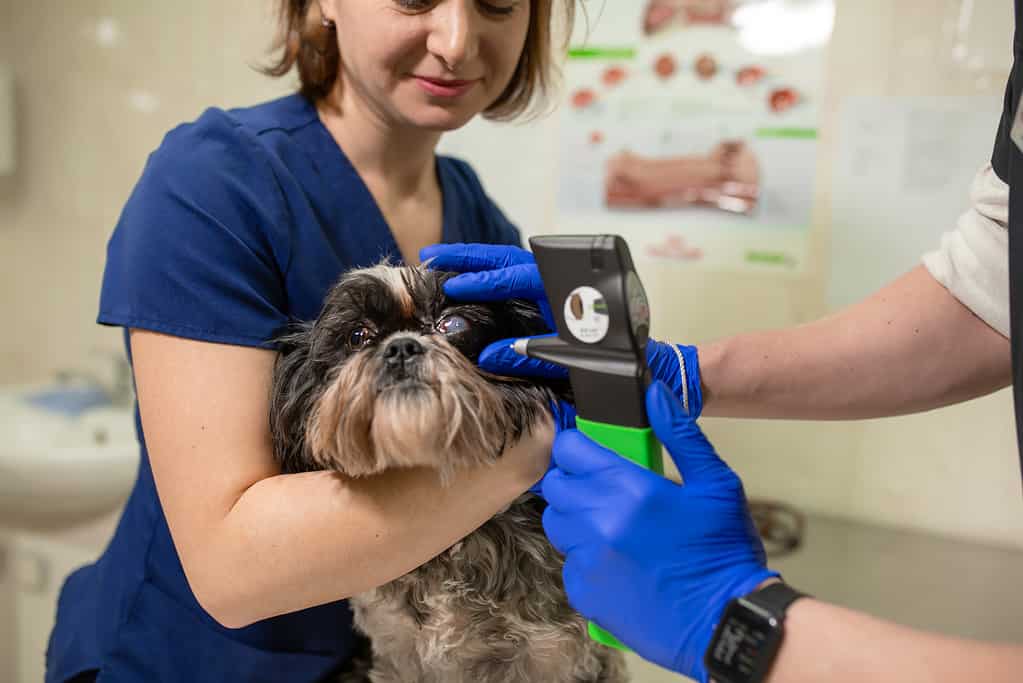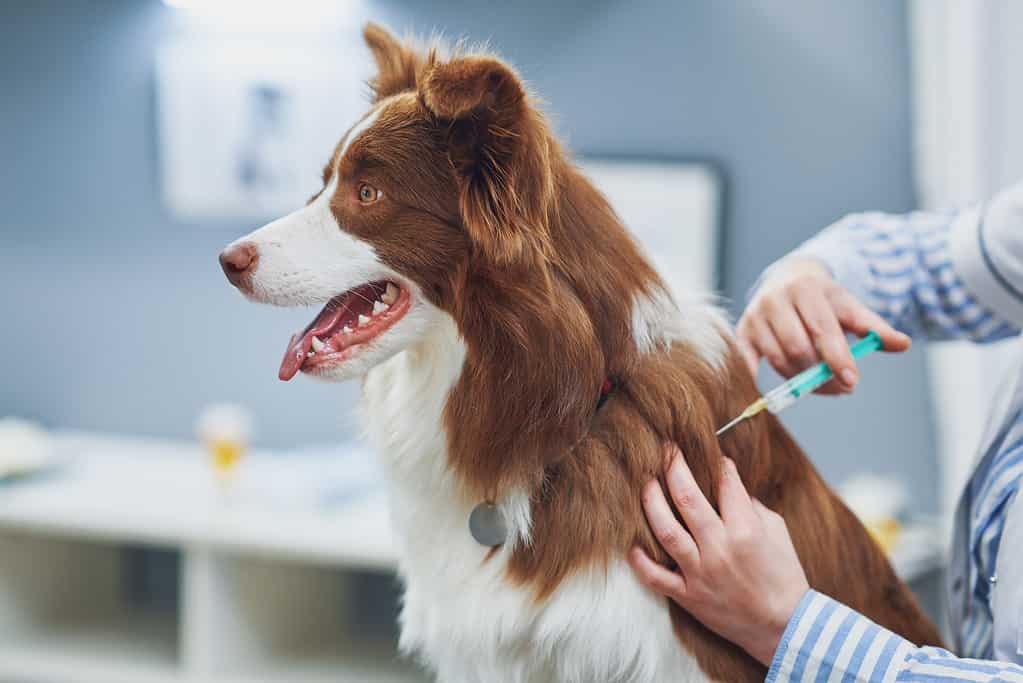Ranked as the 12th most popular dog breed by the American Kennel Club (AKC), the Australian shepherd (Aussie) is a fan-favorite dog breed that has gained popularity with families across the country. While the Australian shepherd is well-known for its intelligence and loving personality, they are also known for having several health issues. Being aware of these problems before they arise will give any pet parent a better chance at keeping their adorable puppy in good health.
This article will highlight several common health problems seen in Australian shepherds, the signs of each disease, and tips on how to keep Aussies healthy.
11 Health Problems of Australian Shepherds
1. Hip Dysplasia

An x-ray of a dog with a red highlighted region where hip dysplasia is primarily focused.
©Intarapong/Shutterstock.com
Hip Dysplasia is the condition when the hip joint loosens, causing dysfunction or pain when moving. This is a naturally occurring condition that develops as dogs (especially large breed dogs) get older and they lose cartilage or muscle in their hips.
Symptoms of hip dysplasia are:
- Limping with no previous injury
- Chronic lameness
- Difficulty getting up or lying down
- Small hopping when trying to run (as if limping)
- Sitting on the hip instead of on the back paws and rear
2. Elbow Dysplasia

A 3D render of a dog skeleton where elbow dysplasia will be most affected.
©humonia/iStock via Getty Images
Elbow dysplasia is the condition where bones in the elbows are altered during growth, leading to unbalanced weight distribution on the joints. This uneven weight balance can cause pain or arthritis as the joints are not able to support the dog’s weight properly.
Australian shepherds are genetically more likely to develop this than many other dogs. While not every Australian shepherd will develop it, it can also develop through environmental factors such as obesity during puppyhood.
Symptoms of elbow dysplasia are:
- Swollen elbows
- Thickened joints
- Decreased range of motion
- Joint pain
- Elbows bulging out toward the side
- Abnormal or uneven gait while walking or standing
- Hesitance to run or play
3. Hypothyroidism

Veterinarian checking the thyroid gland on a dog, located on the sides of the neck.
©megaflopp/iStock via Getty Images
Hypothyroidism is the condition where the thyroid glands are not producing enough hormones to balance the dog’s metabolism. Australian shepherds are one of hundreds of dogs susceptible to experiencing hypothyroidism due to genetics, diet, or natural aging.
Unfortunately, hypothyroidism is typically a lifelong illness, and it has to be managed carefully with a proper diet and medication to balance the hormones the Australian shepherd is missing. Without well-regulated hormonal control, Australian shepherds may become susceptible to other health risks like obesity or auto-immune diseases such as tumors or cancer.
Symptoms of hypothyroidism are:
- General weakness in the body
- A sudden increase in weight
- Swollen thyroid glands in the neck
- Hair loss
- Dry or dull coat
- Lethargy or inactivity
- Difficulty with colder temperatures
- Flaky and dry skin
- Excessive shedding
4. Cataracts

Cataracts is easily identified by the greying of the eyeball, preventing light from entering the eye, causing limited visibility.
©Kateryna Kukota/iStock via Getty Images
Australian shepherds are one of the few dog breeds that are genetically predisposed to eye issues. Many are born with a unique condition called heterochromia, which is when the eyes are two different colors.
However, their gorgeous eyes may weaken over time, and they develop a disease called cataracts. Cataracts are when the lens of the eyes becomes cloudy, limiting the amount of light and dulling images for the Aussie to understand. Aussies have a higher chance of developing this as they age. Over time, an Aussie may have partial sight loss or total blindness.
Cataracts can easily be detected early and supported with the help of a medical professional. Doctors at the AKC recommend cataract surgery performed by the American College of Veterinary Ophthalmologists to restore a dog’s eyesight, but it is still possible for an Aussie to live a comfortable life without surgery.
5. Collie Eye Defect

Two Australian shepherds, the right with matching colored eyes and the left with with Heterochromia.
©Eve Photography/Shutterstock.com
Collie Eye Defect or Collie Eye Anomaly is a genetic situation where the blood vessels in the eyes are underdeveloped. This can lead to several consequences like cataracts, blindness, or in more severe cases, retinal detachment. Once the defect has been present, it will steadily hinder all parts of the eyeball like the lens, retina, optic disc, and iris.
Herding dogs such as Australian Shepherds, Lancashire heelers, and collies are known for developing this anomaly. Surgery is possible to mitigate the effects of Collie Eye Defect, but it cannot reverse the condition. This is a genetic condition where one of the parents has to have the defect already and is passed down to their offspring.
Symptoms of Collie Eye Defect are:
- Eyeballs noticeably smaller than normally
- Eyeballs are sunken into their sockets
- Cloudy haze in the eyes
6. Progressive Retinal Atrophy

Due to Collie’s natural inclination for heterochomia, they are at a higher risk for other eye disorders.
©ItsWolfeh / CC BY-SA 3.0 – License
Progressive Retinal Atrophy (PRA) is another degenerative disease focused on the eyes. These degenerative diseases affect the retinas, limiting the amount of light the eyes can absorb. The cells steadily degrade, restricting the dog’s vision. In severe cases, an Aussie can go completely blind.
PRA is not painful and will affect an Aussie more at night as there is less light available to take in. This is another disease that is hereditary for Aussies as they are already vulnerable to eye complications.
PRA is a slow and steady progression of degeneration it may start with an Aussie struggling with seeing at night. It may soon progress to having difficulty seeing in dim light, to eventually daytime. However, Aussies have a very keen sense of smell and hearing. Despite their loss of eyesight, they can still live a happy and healthy life.
7. Multi-Drug Sensitivity

Australian Shepherd being vaccinated with a moderated dosage to limit the risk of MDR1.
©iStock.com/macniak
Multi-Drug Sensitivity (MDR1) is a genetic situation where dogs have a higher risk of life-threatening complications after taking medications. Aussies and akitas are well-known for being highly sensitive to medications, especially those involving anesthesia.
An Aussie with this genetic intolerance may put them at risk in case they need surgery, worm prevention or elimination medications, or anti-cancer medications. Combining medications can be equally dangerous since too many could leave them in a life-threatening situation.
There is no treatment option for MDR1, but pet parents can inform their veterinarian if their Aussie has any drug sensitivity before administering any medication. Keeping a record of what drugs and level of tolerance is the optimal way of keeping an Aussie safe.
Symptoms of MDR1 are:
- Vomiting
- Weakness
- Poor coordination
- Tremors
- Seizures
- Blindness
8. Epilepsy

Australian shepherd at full size and adolescent size.
©cynoclub/Shutterstock.com
Epilepsy is the sudden surge of uncontrollable neural activity. This should not be confused with seizures, which are a single instance of convulsions or abnormal electrical activity in the brain. A simple way to remember the difference is that seizures are a single episode, and epilepsy is a reoccurrence of such episodes. Depending on the severity of the situation, a seizure can last from 1-10 minutes with active signs of convulsions and loss of mobility.
Aussies have a higher risk of developing epilepsy if one of their parents suffers from the condition.
However, it is not a primarily genetic condition, and any dog can experience epilepsy via:
- Head trauma
- Liver disease
- Kidney failure
- Low oxygen levels in the blood
- Exposure to toxins (chemicals or food)
- Heatstroke
- Brain tumors
Symptoms of a seizure are:
- Collapsing
- Body stiffened
- Convulsions
- Muscle twitching
- Loss of consciousness
- Drooling
- Chomping
- Foaming at the mouth
While it may prove difficult to see your Aussie in such a delicate and jarring state, it is important to remain calm so you can help them once they recover.
Tips to help an Aussie during a seizure:
- Take a deep break and remain calm
- Quickly record when the episode started and when it ends
- Note what was happening before and after the incident
- Record if this is a single occurrence or continuous
- Do not try to grab or hold them, as they may accidentally bite from loss of muscle control
- Once the seizure is over, speak in a soft tone and reassure them you are there
- Seek a medical professional as soon as possible to find the cause of episodes
9. Lymphosarcoma

Veterinarians use a needle to grab samples of possible cancerous tumors to determine if they are benign or malignant.
©Michael Wallis/iStock via Getty Images
Lymphosarcoma (Lymphoma or LSA) is a specific type of cancer that affects the lymph nodes, bone marrow, or spleen. It is one of the most common types of cancer in dogs and can easily spread throughout the body due to how interconnected the lymphatic system is to the rest of the body.
It is common for Aussies to develop this LSA, they are not the only dogs susceptible. LSA is also commonly found in Golden retrievers, boxers, and Bernese Mountain dogs.
Once LSA has been detected, it is imperative to have it addressed and managed with an anti-cancer regimen. However, Aussies can be sensitive to anti-cancer drugs, making a cancer diagnosis exceptionally scary for pet parents. A lot of work and communication is vital to ensuring an Australian shepherd’s health is stable and well-managed.
Symptoms of Lymphoma are:
- Weakness
- Lethargy
- Loss of appetite
- Weight loss
- Enlarged lymph nodes (on the neck or behind the knees)
10. Hemangiosarcoma

Technician using a microscope to view tumor slides to determine if cancer is malignant or bengin.
©bezikus/Shutterstock.com
Hemangiosarcoma is a cancer where a mass of blood cells forms in the liver, spleen, heart, or other parts of the body. Aussies are likely to develop this particular type of cancer when they are middle-aged (7-8 years old) or seniors (9 and older).
Similar to LSA, hemangiosarcoma is common in Aussies, as well as large breed dogs like German shepherds, Labrador retrievers, or pit bulls.
The most common type of hemangiosarcoma an Aussie may experience is splenic, which is primarily focused on the spleen. The spleen is pivotal in producing new blood cells and combating infection. Once the spleen has been compromised, it will take a toll on the patient quickly.
Treating an Aussie with hemangiosarcoma is just as precarious as LSA due to their low tolerance for medications.
Symptoms of hemangiosarcoma are:
- Overall weakness
- Pale gums
- Lethargy
- Decreased appetite
- Distended abdomen
11. Obesity

Keeping an Australian shepherd on a routine exercise regiment to vent out their energy will keep them in good health and prevent obesity.
©Dmytro Bosnak/iStock via Getty Images
Australian shepherds are great for loving families, but they need to be exercised regularly as they are high-energy dogs. Thanks to modern living, it is easy for an Aussie to become overweight or obese due to inactivity or walks that do not sufficiently deplete their energy.
Obesity is a common health concern with dogs today. The breed’s cute colors, medium stature, and loving personality make it great as a family dog, but without proper exercise and a healthy diet, they may become overweight which can put them at a higher risk for other health issues like arthritis, hip and elbow dysplasia, or cancer.
On average, a healthy-sized Australian shepherd should weigh 50-65 pounds for a male, and 40-55 pounds for a female.
Tips to keep an Aussie Healthy

A gorgeous brown Australian shepherd in the snow.
©Appalousa / CC BY-SA – License
- Bring them to regular veterinary visits to catch any health complications before they arise.
- Perform two or three walks a day, each for 20-30 minutes each.
- Portion their food properly and prevent free feeding as this may lead to eating when bored.
- Communicate with veterinary professionals regarding medication sensitivity.
- Keep a detailed account of medical history, vaccine history, and diagnostic testing.
Groom regularly with a wired brush to keep their coat clean.
Australian shepherds are wonderful companions for the whole family. They may have some health issues every pet parent should be aware of, but there is no definitive measure that an Aussie will experience these issues. Every Aussie has their genetics, history, and personality where understanding them as an individual is the best way of recognizing when something might be wrong and when to act to keep them healthy.
The photo featured at the top of this post is © Alpeek/Shutterstock.com
Ready to discover the top 10 cutest dog breeds in the entire world?
How about the fastest dogs, the largest dogs and those that are -- quite frankly -- just the kindest dogs on the planet? Each day, AZ Animals sends out lists just like this to our thousands of email subscribers. And the best part? It's FREE. Join today by entering your email below.
Thank you for reading! Have some feedback for us? Contact the AZ Animals editorial team.






